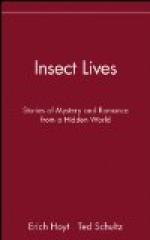When such a moult is about to take place the cuticle separates from the underlying epidermis, and a fluid collects beneath. A delicate new cuticle (see fig. 10 cu’) is then formed in contact with the epidermis, and the old cuticle opens, usually with a slit lengthwise along the back, to allow the insect in its new coat to emerge. At first this new coat is thin and flabby, but after a period of exposure to the air it hardens and darkens, becoming a worthy and larger successor to that which has been cast. The cuticle moreover is by no means wholly external. The greater part of the digestive canal and the whole air-tube system are formed by inpushings of the outer skin (ectoderm) and are consequently lined with an extension of the chitinous cuticle which is shed and renewed at every moult.
In all insects these successive moults tend to be associated with change of form, sometimes slight, sometimes very great. The new cuticle is rarely an exact reproduction of the old one, it exhibits some new features, which are often indications of the insect’s approach towards maturity. Even in some of those interesting and primitive insects the Bristle-tails (Thysanura) and Spring-tails (Collembola), in which wings are never developed, perceptible differences in the form and arrangement of the abdominal limbs can be traced through the successive stages, as R. Heymons (1906) and K.W. Verhoeff (1911) have shown for Machilis. But the changes undergone by such insects are comparatively so slight, that the creatures are often known as ‘Ametabola’ or insects without transformation in the life-history. Now there are a considerable number of winged insects—cockroaches and grasshoppers for example—in which the observable changes are also comparatively slight. We will sketch briefly the main features of the life-story of such an insect.
[Illustration: Fig. 4. Common Cockroach (Blatta orientalis). a, female; b, male; c, side view of female; d, young. After Marlatt, Entom. Bull. 4, U.S. Dept. Agric.]
The young creature is hatched from the egg in a form closely resembling, on the whole, that of its parent, so that the term ‘miniature adult’ sometimes applied to it, is not inappropriate. The baby cockroach (fig. 4 d) is known by its flattened body, rounded prothorax, and stiff, jointed tail-feelers or cercopods; the baby grasshopper by its strong, elongate hind-legs, adapted, like those of the adult, for vigorous leaping. During the growth of the insect to the adult state there may be four or five moults, each preceded and succeeded by a characteristic instar[4]. The first instar differs, however, from the adult in one conspicuous and noteworthy feature, it possesses no trace of wings. But after the first or the second moult, definite wing-rudiments are visible in the form of outgrowths on the corners of the second and third thoracic segments. In each succeeding instar these rudiments become more




